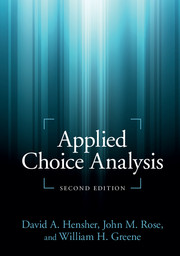Book contents
- Frontmatter
- Contents
- List of Figures
- List of Tables
- Preface
- Part I Getting started
- Part II Software and data
- Part III The suite of choice models
- 11 Getting started modeling: the workhorse – multinomial logit
- 12 Handling unlabeled discrete choice data
- 13 Getting more from your model
- 14 Nested logit estimation
- 15 Mixed logit estimation
- 16 Latent class models
- 17 Binary choice models
- 18 Ordered choices
- 19 Combining sources of data
- Part IV Advanced topics
- Select glossary
- References
- Index
19 - Combining sources of data
from Part III - The suite of choice models
Published online by Cambridge University Press: 05 June 2015
- Frontmatter
- Contents
- List of Figures
- List of Tables
- Preface
- Part I Getting started
- Part II Software and data
- Part III The suite of choice models
- 11 Getting started modeling: the workhorse – multinomial logit
- 12 Handling unlabeled discrete choice data
- 13 Getting more from your model
- 14 Nested logit estimation
- 15 Mixed logit estimation
- 16 Latent class models
- 17 Binary choice models
- 18 Ordered choices
- 19 Combining sources of data
- Part IV Advanced topics
- Select glossary
- References
- Index
Summary
Introduction
This chapter provides a review of the methods in practice, and advances in recent years, of ways of combining revealed preference (RP) and stated preference (SP) data in the estimation and application of choice models. The focus is on both the theory underlying the pooling of data sources as a guide to relevant practice, as well as a step by step outline of how choice models are structured and estimated. We use a mode choice example involving existing and new modes to illustrate the practicalities of application.
Choice model specification, estimation, and application has a very long history, centered originally on the use of RP data. Behavior observed in an actual market through the collection of RP data contains information about a current market equilibrium process. Figure 19.1(a) shows a simple transport example of a market with five modes (walk, bicycle, bus, train, and car) and certain cost and speed characteristics.
The technology frontier reflected in choice data collected from an existing market can be characterized by the following (Louviere et al. 2000):
Technological relationships: By definition, RP data describes only those alternatives that exist, which implies that existing attribute levels and correlations between attributes will be in any model estimated from such data.
- Type
- Chapter
- Information
- Applied Choice Analysis , pp. 836 - 896Publisher: Cambridge University PressPrint publication year: 2015
- 1
- Cited by



